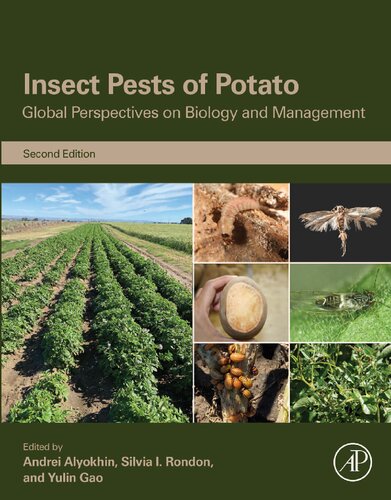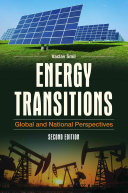Insect Pests of Potato Global Perspectives on Biology and Management 2nd Edition by Andrei Alyokhin, Silvia I Rondon, Yulin Gao ISBN 9780128212370 0128212373
$50.00 Original price was: $50.00.$25.00Current price is: $25.00.
Insect Pests of Potato Global Perspectives on Biology and Management 2nd Edition by Andrei Alyokhin, Silvia I Rondon, Yulin Gao – Ebook PDF Instant Download/Delivery: 9780128212370 ,0128212373
Full download Insect Pests of Potato Global Perspectives on Biology and Management 2nd Edition after payment

Product details:
ISBN 10: 0128212373
ISBN 13: 9780128212370
Author: Andrei Alyokhin, Silvia I Rondon, Yulin Gao
This fully revised and updated second edition of Insect Pests of Potato now includes an opening section with a basic overview of agronomic and economic issues as they relate to potato production. It also features a new section that reviews potato production, as well as problems caused by insect pests and solutions to these problems, in all major potato-growing regions of the world. Further, a new section discusses theoretical foundations of potato pest management and includes chapters on ecological theory, evolutionary theory, and a case study on their applications to elucidate differences between Eastern and Western populations of Colorado potato beetle in North America. There is also a new chapter on the foundations of integrated pest management and their applications in controlling insect pests.
The sections on the biology of main pests and on control methods now feature the latest information, including emphasis on recent advances in molecular biology and genomics. Information on the use of dsRNA technology for pest control is also included, as are new chapters on potato ladybirds and on hemipterous pests other than aphids and psyllids.
This second edition provides improved integration and logical connections among chapters and expanded geographic scope of coverage making it the ideal reference on the topic.
- Fully revised and updated with new sections on potato-growing regions and theoretical foundations of potato pest management using ecological theory, evolutionary theory and relevant case study insights
- Contains improved integration and logical connections among chapters, expanded geographic scope of coverage, and scientific advances
- Emphasizes recent advances in molecular biology and genomics, including the use of dsRNA technology for pest control
Insect Pests of Potato Global Perspectives on Biology and Management 2nd Edition Table of contents:
Part I. Potato as an important staple crop
Chapter 1. Potatoes and their pests: setting the stage
1.1. History and present status
1.2. Potatoes and human civilization
1.3. Insect pests
1.4. Meeting the challenge
Chapter 2. Growing potatoes
2.1. Introduction
2.2. Geographic distribution
2.3. Climate requirements
2.4. Soil requirements
2.5. Soil reaction (pH)
2.6. Major inputs: nitrogen, phosphorus, potassium, sulfur, and organic matter
2.7. Irrigation requirements
2.8. Seed planting depth, spacing, and hilling
2.9. Time to maturity
2.10. Types of cultivars
2.11. Remote sensing
Chapter 3. Economic considerations in potato production
3.1. Introduction
3.2. Economics of seed pricing and production
3.3. Frozen processed potatoes
3.4. Potato chips
3.5. Fresh potatoes
3.6. Storage economics
3.7. US potato consumption trends
3.8. Potato demand
3.9. Global trends and future prospects for potato demand in developing countries
Part II. Biology of major pests
Chapter 4. Colorado potato beetle
4.1. Taxonomy and morphological description
4.2. Origins and history of spread
4.3. Genetic variability
4.4. Pest status and yield loss
4.5. Seasonal life cycle and diapause
4.6. Interactions with host plants
4.7. Reproduction and individual development
4.8. Movement and dispersal
4.9. Management implications
Chapter 5. Aphids
5.1. Basic biology
5.2. Interactions with host plants
5.3. Virus transmission
5.4. Management approaches
5.5. Summary and future directions
Chapter 6. Psyllids
6.1. Introduction
6.2. Potato psyllid (Bactericera cockerelli)
6.3. Other psyllids
6.4. Final remarks
Chapter 7. Wireworms as pests of potato
7.1. Introduction
7.2. Elaterid biology
7.3. Species of economic importance in the holarctic
7.4. Differences within economic species
7.5. Wireworms and the potato crop
7.6. Sampling
7.7. Wireworm control
7.8. Conclusions
Chapter 8. Potato tuberworm
8.1. Taxonomy of P. operculella and other “tuberworms”
8.2. Phthorimaea operculella distribution around the world
8.3. Host range
8.4. Life cycle
8.5. Life table
8.6. Damage in the field
8.7. Damage from field to storage
8.8. Developmental thresholds and temperatures
8.9. Monitoring Phthorimaea operculella
8.10. Integrated pest management of P. operculella
8.11. Conclusions
Chapter 9. Hemipterans, other than aphids and psyllids affecting potatoes worldwide
9.1. Introduction
9.2. Leafhoppers
9.3. Planthoppers
9.4. True bugs
9.5. Conclusion
Chapter 10. Potato ladybirds
10.1. Underappreciated defoliator
10.2. Morphology
10.3. Geographic distribution, host range, and taxonomy
10.4. Damage
10.5. Biology
10.6. Management
10.7. Conclusions and future directions
Part III. Management approaches
Chapter 11. Chemical control
11.1. Introduction
11.2. Early history of chemical control in potatoes
11.3. The pesticide treadmill
11.4. A plethora of chemical control options still available in the 21st century
11.5. Insecticide options for organic potatoes
11.6. Chemical control of hemipteran pests
11.7. Chemical control of wireworms
11.8. Chemical control of potato tuberworm
11.9. Final thoughts
Chapter 12. Insecticidal RNA interference (RNAi) for control of potato pests
12.1. Introduction
12.2. Parameters affecting insecticidal activity of dsRNA
12.3. Delivery of dsRNA to potato pests
12.4. Safety of insecticidal dsRNA
12.5. Use of dsRNA against potato pests
12.6. Resistance to dsRNA and management in potato
12.7. Conclusions and future prospects
Chapter 13. Biological and behavioral control of potato insect pests
13.1. Introduction
13.2. Natural enemies of major potato pests
13.3. Biological and behavioral control deployments
13.4. Endophytic fungi
13.5. Pheromones for monitoring and population management
13.6. Interactions of biological and behavioral control
13.7. Current and future research needs
13.8. Conclusion
Chapter 14. Potato resistance against insect herbivores
14.1. Introduction
14.2. Natural variation in potato insect resistance
14.3. Engineered resistance
14.4. Constraints on host plant resistance
14.5. Future directions
Chapter 15. Cultural control and other non-chemical methods
15.1. Introduction
15.2. Management of abiotic conditions
15.3. Management of biotic conditions
15.4. Examples of habitat management
15.5. Concluding remarks
Part IV. Problems and solutions in major potato-producing areas of the world
Chapter 16. Latin America potato production: pests and foes
16.1. History of potato production in Latin America
16.2. Unintentional and intentional breeding efforts
16.3. Potato’s contribution to the national economies
16.4. Potato issues in Latin America
16.5. Integrated pest management approach to control pest problems in potatoes: common issues across diverse regions
16.6. Main pests affecting potato production in Latin America
16.7. Natural enemies
Chapter 17. The United States of America and Canada
17.1. Introduction
17.2. Potato farming in overall economy
17.3. Local agroclimatic conditions
17.4. Main producers and market conditions
17.5. Main insect pests
17.6. Methods of pest control
17.7. Problems and perspectives
Chapter 18. Regional overview of potato pest problem in EU
18.1. Potato has been cultivated in Europe for over 500 years
18.2. Two major pests of potato in Europe
18.3. Potato farming was worth EUR 11 billion in 2017
18.4. Biggest current pest problems
18.5. Means of mitigating pest problems
18.6. Future challenges
Chapter 19. Russian Federation, Belarus, and Ukraine
19.1. History and local characteristics of potato production
19.2. Russian Federation
19.3. Republic of Belarus
19.4. Ukraine
19.5. Summary and conclusions
Chapter 20. China and Central Asia
20.1. Potato production in China and Central Asia
20.2. Abundance, the relative importance of potato pests in China and Central Asia
20.3. Management practices of key potato pests in China and Central Asia
20.4. Conclusions
Chapter 21. Insect pests of potato in India: biology and management
21.1. Introduction
21.2. Root and tuber-eating pests
21.3. Sap-feeding pests
21.4. Leaf-eating and defoliating insects
Chapter 22. Australia and New Zealand
22.1. Overview of the industry
22.2. Main pests
22.3. Control methods
Chapter 23. Management of potato pests and diseases in Africa
23.1. Overview
23.2. Potato pests and diseases
23.3. Pest and disease management practices
23.4. Conclusion
Part V. Basic science in potato pest management
Chapter 24. Evolutionary considerations in potato pest management
24.1. Introduction
24.2. Fundamentals of evolution
24.3. Applied evolution
24.4. Evolution in agricultural ecosystems
24.5. Evolutionary process of becoming a pest
24.6. An obscure leaf beetle turns into a major pest of potatoes
24.7. Insecticide resistance
24.8. Interactions with abiotic environment
24.9. Human turn to adapt?
24.10. Conclusions
Chapter 25. Ecology of a potato field
25.1. “Potatoes partly made of oil”
25.2. An underappreciated challenge
25.3. Healthy soils and healthy plants
25.4. Dawn of the killer fungi
25.5. The power of connections
Chapter 26. Ecological and evolutionary factors mitigating Colorado potato beetle adaptation to insecticides
26.1. Introduction
26.2. Genetic variation
26.3. Pesticide use
26.4. Noncrop host plants
26.5. Natural enemies
26.6. Crop rotation
26.7. Climate suitability
26.8. Future research
26.9. Conclusion
Part VI. Current challenges and future directions
Chapter 27. Integrated Pest Management (IPM) in potatoes
27.1. What is IPM?
27.2. The elements of IPM
27.3. An IPM strategy for potatoes typical in Australia
27.4. Taught everywhere but typically slow and low rates of adoption. Why?
27.5. Changing to IPM when a crisis occurs or avoiding a crisis. Examples beyond potatoes
27.6. How to achieve rapid adoption of IPM in the absence of a crisis
27.7. Conclusion
Chapter 28. Epilogue: the road to sustainability
Index
People also search for Insect Pests of Potato Global Perspectives on Biology and Management 2nd Edition:
potato insects pictures
potato insect pests
what insects eat pests
what animal or insect eats garden pests
major insect pest of potato
Tags: Andrei Alyokhin, Silvia I Rondon, Yulin Gao, Insect Pests, Potato, Management
You may also like…
Business & Economics - Responsibility and Business Ethics
Reference - Genealogy & Family History
Biology and other natural sciences - Human Biology
Interdisciplinary and Global Perspectives on Intersex Megan Walker
Business & Economics - Management & Leadership
Business & Economics - Management & Leadership
Global Perspectives on Indian Spirituality and Management Sanjoy Mukherjee
Business & Economics - Management & Leadership
Managing Emergencies and Crises Global Perspectives 2nd Edition Naim Kapucu
Uncategorized
Energy Transitions Global And National Perspectives 2nd Edition Professor Of Geography Vaclav Smil











